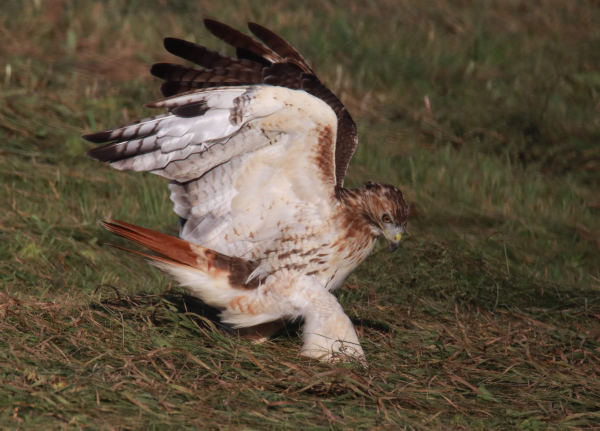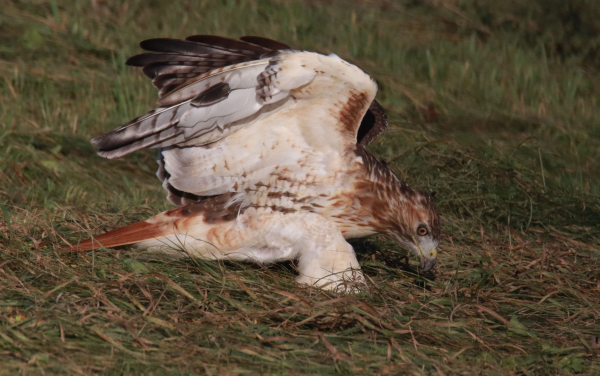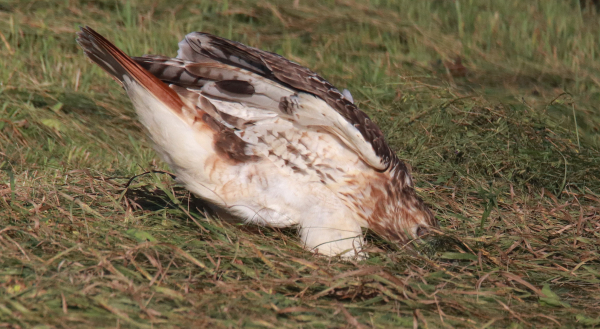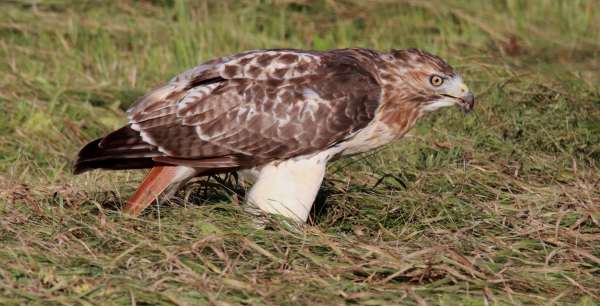Red-tailed Hawks have been the most common raptors in the area for several weeks, and I was momentarily surprised to find an adult standing near the road ahead, possibly with newly caught prey. Slowing down to a glide until the sunlight was illuminating the hawk in the best way, I realized that the Red-tail actually seemed to be on the hunt. The hawk was standing tall, watching the recently cut grass for movement, movement that probably attracted raptor to ground level in the first place. The hawk would occasionally reach forward into the grass with an open foot, even stomping an extended foot as if trying to scare a hidden small animal to move into sight. Of course, I had my camera lens focused on the hawk as soon as I turned the van’s engine off.

I followed the hawk’s movements with an element of curiosity, and anticipated it might connect with a snake, vole, or mouse. The hawk continued its slow, measured pursuit, walking a step forward, reaching out, taking a few steps, watching, then testing the grass with its feet again; but definitely following something’s measured movements in the grass. Betting it was a garter snake, I was hoping the intent hawk would suddenly make a strike, spreading its wings in the process just at the moment of its pounce, which is quite typical behavior.

The hawk and mouse game continued for more than 5 minutes without sign of a potential prey animal as the hawk moved slowly but steadily in my direction, led by an unseen entity. Suddenly the Red-tail made a more spirited grabbing motion with its right leg and half-heartedly opened its wings, which I reacted to by taking a couple photos. But the scene calmed again, and after regathering itself into an upright position, a moment later the hawk made a rapid strike with an open talon-edged foot as it spread its wings high above its back. That’s exactly what I was hoping for as I reacted instantly by taking a series of attack photos as the raptor continued by leaning forward with its hooked beak to dispatch the “snake in the grass.”

Eventually immersing its face in the grass, the hawk was definitely finalizing the hunt, and as the hunter began feeding I thought I saw gray fur. In a moment the hawk raised its head with a vole in its beak; and not just any vole, but the biggest meadow vole I’ve ever seen. Throughout the ground-based hunt, the Red-tail was unconcerned about my white van, and it finished eating the vole before taking flight to a nearby pole where it ruffled and regained its composure. Having spent worthy time in the company of the big raptor during the prime afternoon sunlight period (around 5:30), I resumed my birding drive to my intended destination of the skeleton tree.
Slowly edging forward to a point where I could turn south while trying not to flush the hawk during my approach, the satiated Red-tail didn’t budge. Of course, my interest in the skeleton tree was to check it for photogenic birds, but what would beat the photo episode this trusting Red-tailed Hawk just provided? And that’s what we all hope for – a trusting bird that will continue with its ongoing behavior without concern for our measured approach and presence within photo range. This photo opportunity was an example of the classic use of a “mobile photo blind” that paid off in a big way.

If you try getting out of the vehicle or try to advance without the cover of the vehicle, you will probably flush the bird without a chance for a photo. Plus the window frame provides a good brace to stabilize your lens on after turning off your ignition. Of course, you hold your breath when taking any photos to help steady the lens all the more, and you want to use the fastest shutter speed possible under circumstances that may have some action involved. When you are in the moment, be on high alert, anticipate the next action, and take as many photos as you can during the few moments that really count.
In this case, patience was also an important element. In hindsight, you could say I predicted the action, but it took some time and more patience to stick with the photo potential presented by the grounded Red-tailed Hawk – but heck, that’s what we are out there for – to search for birds and try for a photo or a series of photographs while observing bird behavior, all while absorbing a bit of nature’s daily drama. Enjoy the birds you photograph, as well as those that don’t give you a chance, enjoy the great outdoors and the beauty of fall that birds animate daily.
Article and Photographs by Paul Konrad
Share your bird photos and birding experiences at editorstbw2@gmail.com